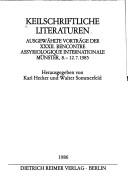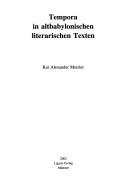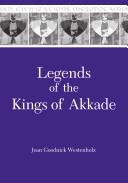| Listing 1 - 10 of 37 | << page >> |
Sort by
|
Book
ISBN: 1633552365 4057664109927 9700000009914 Year: 2012 Publisher: Lanham : Start Publishing,
Abstract | Keywords | Export | Availability | Bookmark
 Loading...
Loading...Choose an application
- Reference Manager
- EndNote
- RefWorks (Direct export to RefWorks)
The Babylonian Legends of the Creation and the Fight Between Bel and the Dragon as Told by Assyrian Tablets From Nineveh contianing the following: ""The Discovery of the Tablets""""Publication of the Creation Tablets""""The Object of the Babylonian Legend of the Creation""""Variant Forms of the Babylonian Legend of the Creation""""The ""Bilingual"" Version of the Creation Legend""""The Legend of the Creation According to Berosus and Demascius""""The Seven Tablets of Creation - Description of Their Contents""""The Seven Tablets of Creation - 1st, 2nd, 3rd, 4th, 5th, 6th, 7th""""Epilogue""
Cosmography --- Assyro-Babylonian literature. --- Akkadian literature --- Babylonian literature
Book
ISBN: 9004323473 9789004323476 9789004323469 9004323465 Year: 2016 Publisher: Leiden
Abstract | Keywords | Export | Availability | Bookmark
 Loading...
Loading...Choose an application
- Reference Manager
- EndNote
- RefWorks (Direct export to RefWorks)
In The Exegetical Terminology of Akkadian Commentaries Uri Gabbay offers the first detailed study of the well-developed set of technical terms found in ancient Mesopotamian commentaries. Understanding the hermeneutical function of these terms is essential for reconstructing the ancient Mesopotamian exegetical tradition. Using the exegetical terminology attested in the large corpus of Akkadian commentaries from the first millennium BCE, the book addresses the hermeneutics of the commentaries, investigates the scholastic environment in which they were composed, and considers the relationship between the terminology of commentaries and the divine authority of the texts they elucidate. The book concludes with a comparative study that traces links between the terminology used in Akkadian commentaries and that used in early Hebrew exegesis.
Assyro-Babylonian literature --- Akkadian literature --- Babylonian literature --- Criticism, Textual
Book
ISBN: 9781107052055 9781107280328 9781107678309 9781108514712 1108514715 110705205X 110728032X 1108505775 1107678307 Year: 2017 Publisher: Cambridge ; New York : Cambridge University Press,
Abstract | Keywords | Export | Availability | Bookmark
 Loading...
Loading...Choose an application
- Reference Manager
- EndNote
- RefWorks (Direct export to RefWorks)
"Women's Writing of Ancient Mesopotamia presents fresh and engaging translations of works that were composed or edited by female scribes and elite women of the ancient Near East. These texts provide insight into the social status, struggles, and achievements of women during the earliest periods of recorded human history (c.2300-540 BCE). In three introductory chapters and a concluding chapter, Charles Halton and Saana Svärd provide an overview of the civilization of ancient Mesopotamia and examine gender by analyzing these different kinds of texts. The translations cover a range of genres, including hymns, poems, prayers, letters, inscriptions, and oracles. Each text is accompanied by a short introduction that situates the composition within its ancient environment and explores what it reveals about the lives of women within the ancient world. This anthology will serve as an essential reference book for scholars and students of ancient history, gender studies, and world literature"-- "These texts provide insight into the social status, struggles, and achievements of women during the earliest periods of recorded human history (ca. 2300 - 540 BCE). In three introductory chapters and a concluding chapter, Charles Halton and Saana Svard provide an overview of the civilization of ancient Mesopotamia and examine gender by analyzing these different kinds of texts. The translations cover a range of genres, including hymns, poems, prayers, letters, inscriptions, and oracles"--
LITERARY CRITICISM / African. --- Assyro-Babylonian literature --- Civilization, Ancient. --- HISTORY / Ancient / General. --- Women authors. --- Iraq --- Civilization --- Ancient civilization --- Akkadian literature --- Babylonian literature

ISBN: 3496008792 9783496008798 Year: 1986 Volume: Bd. 6 Publisher: Berlin: Reimer,
Abstract | Keywords | Export | Availability | Bookmark
 Loading...
Loading...Choose an application
- Reference Manager
- EndNote
- RefWorks (Direct export to RefWorks)
Akkadian literature --- Middle Eastern literature --- Littérature moyen-orientale --- History and criticism --- Congresses --- Histoire et critique --- Congrès --- Assyro-Babylonian literature --- Congresses. --- -Assyro-Babylonian literature --- -Akkadian literature --- Babylonian literature --- Near Eastern literature --- -Congresses --- -History and criticism --- Littérature moyen-orientale --- Congrès --- History and criticism&delete& --- Assyro-Babylonian literature - History and criticism - Congresses --- Middle Eastern literature - History and criticism - Congresses
Book
ISBN: 0802053157 9780802053152 Year: 1975 Volume: 3 Publisher: Toronto: University of Toronto press,
Abstract | Keywords | Export | Availability | Bookmark
 Loading...
Loading...Choose an application
- Reference Manager
- EndNote
- RefWorks (Direct export to RefWorks)
Assyro-Babylonian literature --- Akkadian language --- History and criticism --- Texts --- 892.12 --- -Assyro-Babylonian literature --- -Akkadian literature --- Babylonian literature --- Accadian language --- Assyrian language --- Assyro-Babylonian language --- Babylonian language --- Semitic languages --- Assyrische literatuur --- Assyro-Babylonian literature. --- Texts. --- History and criticism. --- -Assyrische literatuur --- 892.12 Assyrische literatuur --- Akkadian literature --- Assyro-Babylonian literature - History and criticism --- Akkadian language - Texts
Book
ISBN: 0962001341 096200135X Year: 1993 Publisher: BETHESDA : CDL Press,
Abstract | Keywords | Export | Availability | Bookmark
 Loading...
Loading...Choose an application
- Reference Manager
- EndNote
- RefWorks (Direct export to RefWorks)
892.1 --- Akkadian literature --- -Akkadian literature --- Babylonian literature --- Akkadische, Sumerische literatuur --- Translations into English --- Akkadian language --- Assyro-Babylonian literature --- Chronology, Assyro-Babylonian. --- Names, Akkadian. --- Names, Sumerian. --- Sumerian language --- Translations into English. --- -Akkadische, Sumerische literatuur --- 892.1 Akkadische, Sumerische literatuur --- -892.1 Akkadische, Sumerische literatuur
Book
ISBN: 1501504983 9781501504969 1501504967 9781501504976 1501504975 9781501504983 9781501513855 1501513850 Year: 2017 Publisher: Boston ; Berlin : De Gruyter,
Abstract | Keywords | Export | Availability | Bookmark
 Loading...
Loading...Choose an application
- Reference Manager
- EndNote
- RefWorks (Direct export to RefWorks)
Scholars often assume that the nature of Mesopotamian kingship was such that questioning royal authority was impossible. This volume challenges that general assumption, by presenting an analysis of the motivations,methods, and motifs behind a scholarly discourse about kingship that arose in the final stages of the last Mesopotamian empires. The focus of the volume is the proliferation of a literature that problematizes authority in the Neo-Assyrian period, when texts first begin to specifically explore various modalities for critique of royalty. This development is symptomatic of a larger discourse about the limits of power that emerges after the repatriation of Marduk's statue to Babylon during the reign of Nebuchadnezzar I in the 12th century BCE. From this point onwards, public attitudes toward Marduk provide a framework for the definition of proper royal behavior, and become a point of contention between Assyria and Babylonia. It is in this historical and political context that several important Akkadian compositions are placed. The texts are analyzed from a new perspective that sheds light on their original milieux and intended functions.
Assyro-Babylonian literature. --- Marduk (Babylonian deity) --- Akkadian literature. --- Akkadische Literatur. --- Ashurbanipal. --- Assurbanipal. --- Marduk. --- Sanherib. --- Sennacherib. --- Gods, Assyro-Babylonian --- Akkadian literature --- Babylonian literature --- Iraq --- Assyria --- Irak --- Rāfidayn, Bilād --- Bilād al-Rāfidayn --- Republic of Iraq --- Jumhuriyah al Iraqiyah --- History --- Kings and rulers. --- Assyro-Babylonian literature --- Kings and rulers in literature. --- History and criticism.

ISBN: 3934628036 Year: 2002 Volume: 279 Publisher: Münster : Ugarit-Verlag,
Abstract | Keywords | Export | Availability | Bookmark
 Loading...
Loading...Choose an application
- Reference Manager
- EndNote
- RefWorks (Direct export to RefWorks)
Akkadian philology --- Akkadian language --- Philologie akkadienne --- Akkadien (Langue) --- Texts --- Textes --- -Assyro-Babylonian literature --- -Akkadian literature --- Babylonian literature --- Accadian language --- Assyrian language --- Assyro-Babylonian language --- Babylonian language --- Semitic languages --- Tense --- History and criticism --- -Tense --- Assyro-Babylonian literature
Book
ISBN: 048517412X 9780485174120 Year: 1978 Volume: 12 Publisher: London: Athlone,
Abstract | Keywords | Export | Availability | Bookmark
 Loading...
Loading...Choose an application
- Reference Manager
- EndNote
- RefWorks (Direct export to RefWorks)
God --- Assyro-Babylonian literature --- Biblical teaching --- Relation to the Old Testament --- 299.2 --- -Assyro-Babylonian literature --- -Akkadian literature --- Babylonian literature --- Metaphysics --- Misotheism --- Monotheism --- Religion --- Theism --- Godsdiensten van de Semitische volkeren --- Relation to the Old Testament. --- Biblical teaching. --- -Godsdiensten van de Semitische volkeren --- 299.2 Godsdiensten van de Semitische volkeren --- -299.2 Godsdiensten van de Semitische volkeren --- Akkadian literature --- God (Christianity) --- God (Judaism) --- Assyro-Babylonian religion --- God - Biblical teaching --- Assyro-Babylonian literature - Relation to the Old Testament

ISBN: 0931464854 1575063115 1575065037 Year: 1997 Volume: 7 Publisher: Winona Lake, IN : Eisenbrauns,
Abstract | Keywords | Export | Availability | Bookmark
 Loading...
Loading...Choose an application
- Reference Manager
- EndNote
- RefWorks (Direct export to RefWorks)
The most impressive legacy of the Dynasty of Akkade (ca. 2310-2160 B.C.E.) was the widespread, popular legends of its kings. Dr. Westenholz offers an annotated edition of all the known legends of the Akkadian kings, with transliteration, translation, and commentary. Of particular interest to biblical scholars is the inclusion of “The Birth Legend of Sargon,” which is often compared to Moses in Exodus.
Assyro-Babylonian literature. --- Legends --- Assyro-Babylonian literature --- -Akkadian literature --- Babylonian literature --- Folk tales --- Traditions --- Urban legends --- Folklore --- Babylonia --- -Kings and rulers --- Littérature assyro-babylonienne --- Babylone --- Kings and rulers --- Rois et souverains --- Akkadian literature --- Vavilonii︠a︡ --- Bavel --- Bābil --- Babylonien --- Sumer --- Kings and rulers. --- Legends. --- Middle East --- Czars (Kings and rulers) --- Kings and rulers, Primitive --- Monarchs --- Royalty --- Rulers --- Sovereigns --- Tsars --- Tzars --- Heads of state --- Queens --- Orient --- Asia, South West --- Asia, Southwest --- Asia, West --- Asia, Western --- East (Middle East) --- Eastern Mediterranean --- Fertile Crescent --- Levant --- Mediterranean Region, Eastern --- Mideast --- Near East --- Northern Tier (Middle East) --- South West Asia --- Southwest Asia --- West Asia --- Western Asia --- Vavilonii͡
| Listing 1 - 10 of 37 | << page >> |
Sort by
|

 Search
Search Feedback
Feedback About UniCat
About UniCat  Help
Help News
News